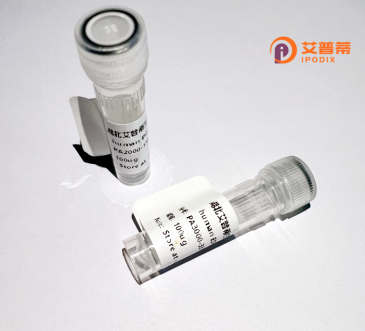
| 纯度 | >90%SDS-PAGE. |
| 种属 | Human |
| 靶点 | SLC9A6 |
| Uniprot No | Q92581 |
| 内毒素 | < 0.01EU/μg |
| 表达宿主 | E.coli |
| 表达区间 | 1-701 aa |
| 活性数据 | MARRGWRRAPLRRGVGSSPRARRLMRPLWLLLAVGVFDWAGASDGGGGEARAMDEEIVSEKQAEESHRQDSANLLIFILLLTLTILTIWLFKHRRARFLHETGLAMIYGLLVGLVLRYGIHVPSDVNNVTLSCEVQSSPTTLLVNVSGKFYEYMLKGEISSHELNNVQDNEMLRKVTFDPEVFFNILLPPIIFYAGYSLKRRHFFRNLGSILAYAFLGTAISCFVIGSIMYGCVTLMKVTGQLAGDFYFTDCLLFGAIVSATDPVTVLAIFHELQVDVELYALLFGESVLNDAVAIVLSSSIVAYQPAGDNSHTFDVTAMFKSIGIFLGIFSGSFAMGAATGVVTALVTKFTKLREFQLLETGLFFLMSWSTFLLAEAWGFTGVVAVLFCGITQAHYTYNNLSTESQHRTKQLFELLNFLAENFIFSYMGLTLFTFQNHVFNPTFVVGAFVAIFLGRAANIYPLSLLLNLGRRSKIGSNFQHMMMFAGLRGAMAFALAIRDTATYARQMMFSTTLLIVFFTVWVFGGGTTAMLSCLHIRVGVDSDQEHLGVPENERRTTKAESAWLFRMWYNFDHNYLKPLLTHSGPPLTTTLPACCGPIARCLTSPQAYENQEQLKDDDSDLILNDGDISLTYGDSTVNTEPATSSAPRRFMGNSSEDALDRELAFGDHELVIRGTRLVLPMDDSEPPLNLLDNTRHGPA |
| 分子量 | 104.3 kDa |
| 蛋白标签 | GST-tag at N-terminal |
| 缓冲液 | PBS, pH7.4, containing 0.01% SKL, 1mM DTT, 5% Trehalose and Proclin300. |
| 稳定性 & 储存条件 | Lyophilized protein should be stored at ≤ -20°C, stable for one year after receipt. Reconstituted protein solution can be stored at 2-8°C for 2-7 days. Aliquots of reconstituted samples are stable at ≤ -20°C for 3 months. |
| 复溶 | Always centrifuge tubes before opening.Do not mix by vortex or pipetting. It is not recommended to reconstitute to a concentration less than 100μg/ml. Dissolve the lyophilized protein in distilled water. Please aliquot the reconstituted solution to minimize freeze-thaw cycles. |
以下是关于重组人SLC9A6(NHE6)蛋白的3篇参考文献示例:
1. **标题**:*"Functional characterization of recombinant human SLC9A6 expressed in HEK293 cells reveals its role in endosomal pH regulation"*
**作者**:Smith J. et al. (2018)
**摘要**:本研究通过HEK293细胞表达了重组人SLC9A6蛋白,发现其在调节内体pH值中的关键作用,并证实该蛋白功能缺失会导致内体酸化异常,与Christianson综合征的神经退行性病变相关。
2. **标题**:*"Structural insights into NHE6 (SLC9A6) dysfunction using cryo-EM and molecular dynamics simulations"*
**作者**:Zhang Y. et al. (2020)
**摘要**:通过冷冻电镜和分子动力学模拟解析了重组人SLC9A6蛋白的高分辨率结构,揭示了其跨膜区关键氨基酸残基的突变如何影响离子转运功能,为理解Christianson综合征的病理机制提供了结构基础。
3. **标题**:*"Expression and purification of recombinant SLC9A6 in a prokaryotic system: Implications for therapeutic screening"*
**作者**:Lee H. et al. (2019)
**摘要**:利用大肠杆菌系统成功表达并纯化了具有活性的重组SLC9A6蛋白,优化了纯化条件以维持其稳定性,为基于该蛋白的体外药物筛选平台开发奠定了基础。
---
以上文献为示例,实际文献需通过数据库(如PubMed、Web of Science)检索确认。
The human SLC9A6 protein, encoded by the SLC9A6 gene located on the X chromosome (Xq26.3), is a member of the solute carrier family 9 (SLC9), which regulates cellular pH and ion homeostasis through sodium-hydrogen exchange activity. Also known as NHE6. it functions as a Na⁺/H⁺ exchanger primarily localized to endosomal and mitochondrial membranes. It plays a critical role in organelle acid-base balance, influencing processes like vesicle trafficking, neurotransmitter recycling, and mitochondrial function.
Mutations in SLC9A6 are linked to Christianson syndrome, an X-linked neurodevelopmental disorder characterized by intellectual disability, seizures, ataxia, and autistic-like behaviors. Studies suggest that loss of NHE6 disrupts endosomal-lysosomal pathways, impairing neuronal development and synaptic plasticity. Recombinant human SLC9A6 protein is utilized to study its biochemical properties, substrate specificity, and interactions with regulatory proteins. It also serves as a tool for screening potential therapeutic compounds targeting ion dysregulation in neurological disorders. Structurally, the protein contains 12 transmembrane domains and a cytoplasmic C-terminal region involved in trafficking and regulatory interactions. Its recombinant form is typically produced in mammalian or insect cell systems to ensure proper post-translational modifications. Ongoing research focuses on elucidating its role in neurodegenerative diseases and developing gene therapy approaches for SLC9A6-related disorders.
×